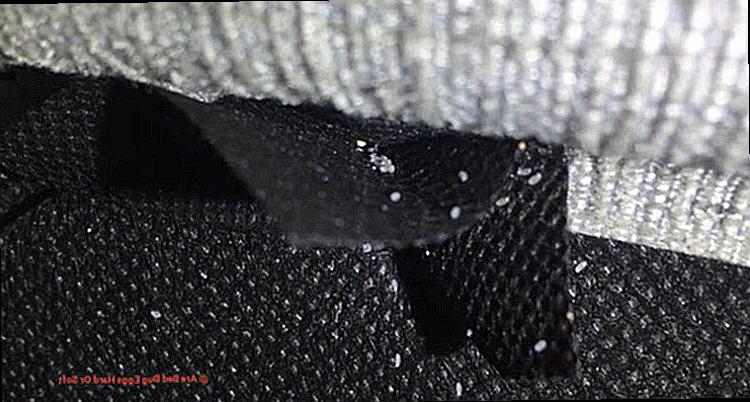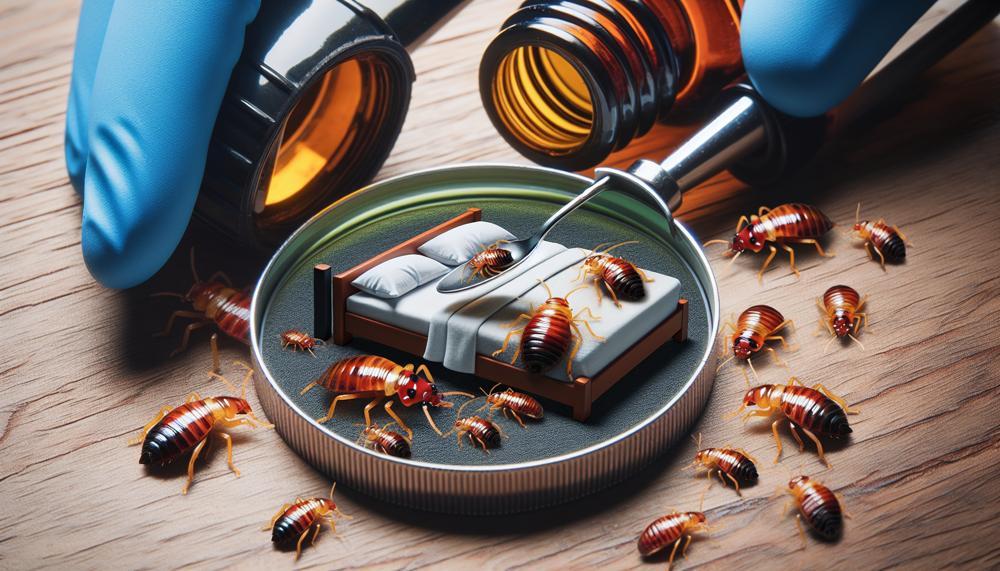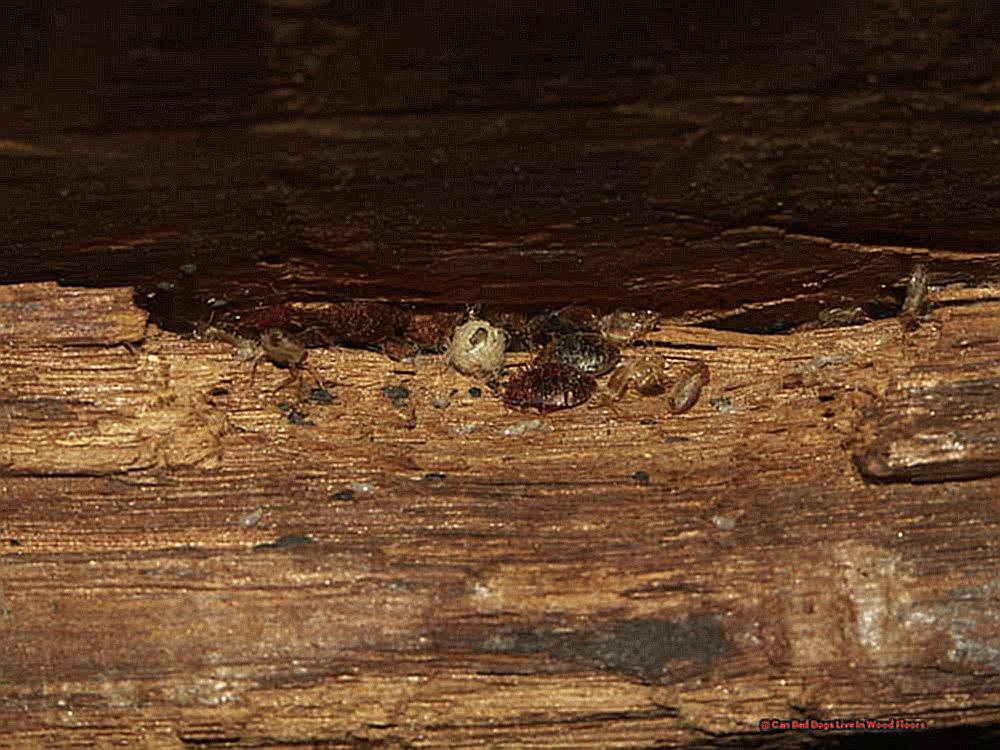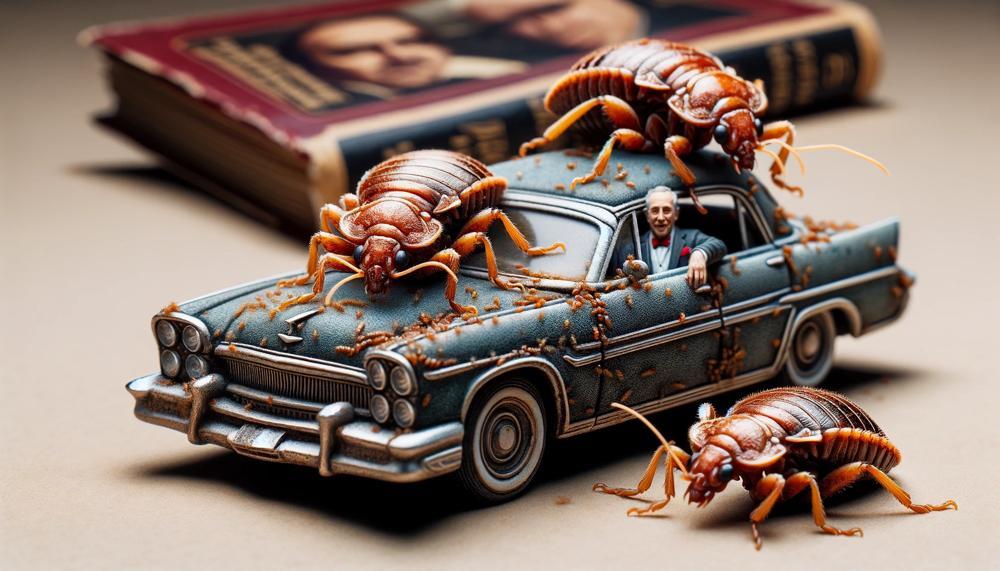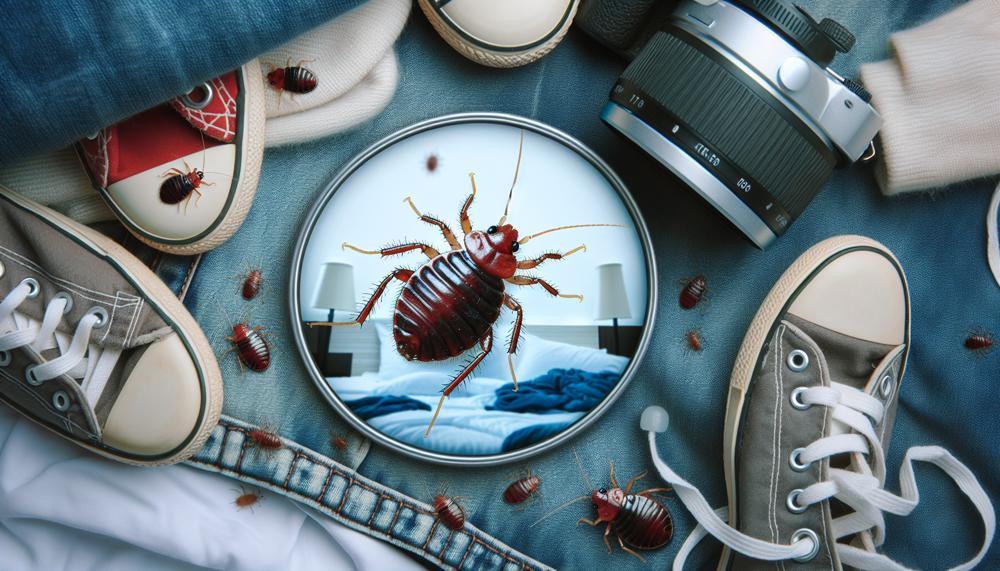Imagine waking up to find itchy bite marks on your skin and dark spots on your bed sheets.
A quick Google search reveals that you may have a bed bug infestation in your home. But did you know that these pesky insects are more than just bloodsuckers?
They also have the surprising ability to eat wood. That’s right, these tiny creatures can feast on the very structure of your home.
So, grab a cup of coffee and get ready to discover the hidden talents of these pests.
Table of Contents
- 1 Can Bed Bugs Live in Wood Furniture?
- 2 Can Bed Bugs Live in the Wood Floor?
- 3 Are Bed Bugs Attracted to Wood?
- 4 Do Bed Bugs Lay Eggs on Wood?
- 5 Can Bed Bugs Burrow into Wood?
- 6 Can Bed Bugs Eat Through Wood?
- 7 Can Bed Bugs Live in Cedarwood?
- 8 Signs of Bed Bugs on Wood
- 9 How to Remove Bed Bugs From Wood Furniture – Step by Step Instruction
- 10 How to Treat Wood for Bed Bugs – The Best Products
- 11 Bed Bug Marks on Wood: How to Clean Bed Bug Feces on Wood
Can Bed Bugs Live in Wood Furniture?
Bed bugs, those pesky pests that have been plaguing homes for centuries, are a nuisance that no one wants to deal with. These tiny, reddish-brown insects may seem harmless at first, but their bites can cause great discomfort and frustration. While they do not transmit diseases, their presence can lead to itchy welts and allergic reactions in some individuals. Bed bugs are known for their ability to adapt and survive in various environments, including wood furniture. In this guide, we will explore the signs of bed bug infestation in wood furniture and how to effectively treat it.
So, Can Bed Bugs Really Infest Wood Furniture?
Unfortunately, the answer is yes. Bed bugs are adaptable creatures and can make themselves at home in any type of furniture as long as there are tiny gaps for them to hide in. This includes wood furniture, which is often found in bedrooms and living rooms where humans spend a lot of time. While they cannot burrow into solid wood surfaces, they can still use it as a means of transportation. Additionally, bed bugs can also infest metal and plastic furniture if there are cracks or gaps for them to hide in.
But Why Do Bed Bugs Prefer Wood Furniture?
Wood furniture offers the perfect combination of warmth, moisture, and small spaces for bed bugs to hide and lay eggs. These insects may not feed on wood like termites do, but they can pierce the skin with their elongated mouthparts to feed on blood from humans or animals. Unlike other insects, bed bugs go through incomplete metamorphosis, meaning they do not have a pupal stage. This makes them difficult to find as they can quickly crawl into tiny spaces.
How Can You Tell If Your Wood Furniture is Infested?
Identifying a bed bug infestation in wood furniture can be tricky, but there are some signs to look out for. These include:
Can Bed Bugs Live in the Wood Floor?
Bed bugs are among the most dreaded pests in a household, and for valid reasons. These minuscule, blood-sucking creatures can create a living nightmare as they invade your home and disrupt your peace of mind. While we often associate bed bugs with bedding and furniture, can they also infest wood floors? The simple answer is yes, and here’s why.
How Do Bed Bugs Invade Wooden Floors?
Bed bugs are incredibly resilient beings. They can survive for months without feeding, and their flat bodies enable them to squeeze into even the tiniest of cracks and crevices. This means that any potential hiding spot in your home is fair game for these pests, including wooden flooring.
Bed bugs can infest wood floors if they have access to a hiding spot and a source of food (human blood). A single female bed bug is enough to start an infestation as she can lay up to 500 eggs in her lifetime. Wooden flooring provides the perfect environment for bed bugs to conceal themselves during the day, while they come out at night to feast on human warmth and CO2.
In severe infestations, bed bugs may venture out from their usual hiding spots in bedding to lay eggs in floor cracks. While bed bugs typically reside in bedding, some may crawl on the floor if disturbed or searching for a new hiding place.
Do Bed Bugs Consume Wood?
Unlike other burrowing insects like termites or carpenter ants, bed bugs do not feed on wood or any other material besides blood. This means that wooden flooring does not specifically attract bed bugs. However, wooden flooring offers qualities that make it a suitable shelter for bed bugs. The cracks and crevices in wood flooring provide dark, secluded places for these pests to dwell and reproduce.
Are Bed Bugs Attracted to Wood?
While it may not be their source of sustenance, wood can still play a role in their presence in your home. Let’s delve into the relationship between bed bugs and wood to better understand how it affects the likelihood of an infestation.
It’s no secret that bed bugs are masters of hiding, making them notoriously difficult to get rid of. Unfortunately, wood offers plenty of hiding spots for these elusive pests. From wooden bed frames to dressers and headboards, bed bugs can nest and lay eggs in the tight spaces provided by wooden furniture.
But that’s not all. Wood can also make it harder to detect bed bugs. In a cluttered room filled with wooden furniture, flooring, and walls, these tiny insects can easily blend in with their surroundings, making it easier for them to go undetected for extended periods of time.
Moreover, wood is known for its ability to absorb and retain heat – a favorite environment for bed bugs. These pesky creatures are drawn to warmth and thrive in temperatures between 70-80°F. This makes wood the perfect environment for them to live and reproduce, especially when it’s close to a heat source like a radiator or heating vent.
However, the biggest concern with infested wooden furniture is the potential spread of bed bugs. They can easily crawl from one piece of furniture to another or hitchhike on clothing or belongings, quickly spreading throughout your home. Thus, it is crucial to thoroughly inspect and treat all wooden areas if a bed bug infestation is suspected.
In conclusion, while bed bugs do not feed on wood, it provides them with hiding spots, makes detection harder, and offers a warm environment for their survival.
Do Bed Bugs Lay Eggs on Wood?
While we all enjoy the warmth and comfort that comes with wooden furniture and floors, bed bugs have a much different viewpoint. These minuscule creatures view wood as the perfect location to lay their eggs and start a full-blown infestation in your abode. But do these pests truly deposit their eggs on wood? And if so, what measures can we take to prevent it?
To better understand the connection between bed bugs and wood, let’s first dispel any misconceptions – bed bugs indeed lay their eggs on wood. Although they prefer to reside in mattresses and furniture, they are not selective when it comes to selecting a suitable environment for their young. This means that wooden surfaces within your home can also become a breeding ground for these bothersome bugs.
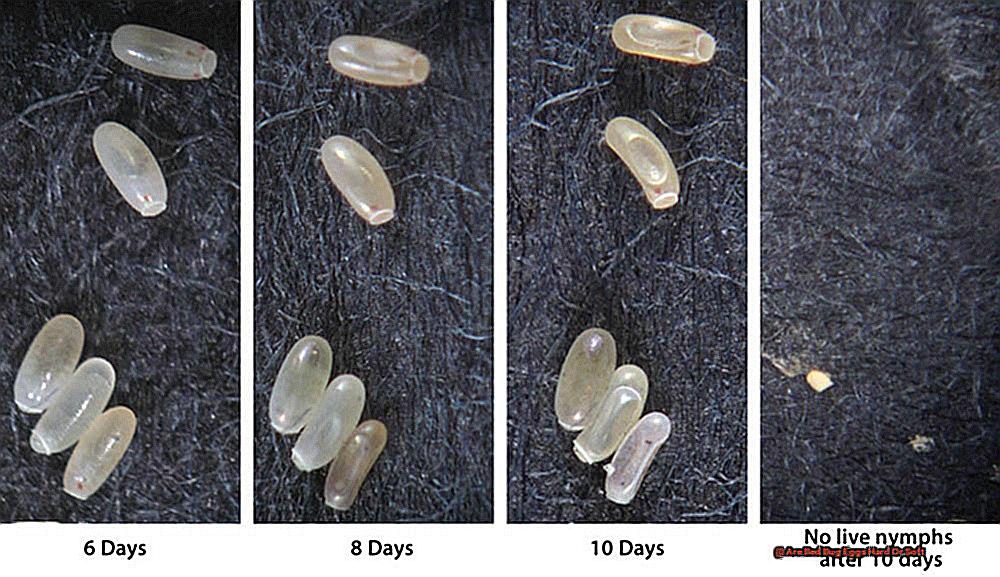
But why wood? For one, bed bugs are drawn to dark and secure spaces – both of which wood provides. Additionally, it offers an abundance of nooks and crannies for them to nest in and lay their eggs, making it an ideal haven for them to flourish.
Where Can Bed Bugs Lay Their Eggs on Wood?
When it comes to wooden surfaces, bed bugs can lay their eggs almost anywhere. This includes cracks and crevices in walls, floors, baseboards, electrical outlets, picture frames, bookshelves – you name it. They are small enough to squeeze into tight areas, making it challenging for us to detect their presence.
Can Bed Bugs Burrow into Wood?
Bed bugs are insidious little creatures that can quickly transform your home into their breeding ground. These minuscule insects are infamous for lurking in crevices and creases, making them challenging to detect and eradicate. But can bed bugs burrow into wood? The simple answer is no, but they can still find sanctuary in the tiny crevices and holes of your wooden surfaces.
To eliminate bed bugs in wood, it’s crucial to take a proactive approach. Here are some tips to safeguard your wooden floors and furniture from these bloodthirsty pests:
Use Pesticide Around Wooden Surfaces
Utilizing a pesticide specifically formulated for bed bugs, spray around the perimeter of your wooden floor or furniture. This will create a barrier and prevent them from crawling onto the surface. Follow the instructions on the pesticide carefully and avoid getting it on any exposed skin or near food.
Thoroughly Clean and Spray Cracks and Crevices
Bed bugs relish hiding in small spaces, so it’s vital to meticulously clean and vacuum any cracks and crevices on your wooden surfaces. After cleaning, use a bed bug spray to treat these areas and exterminate any remaining bugs.
Seal Cracks
To obstruct bed bugs from infiltrating your wooden surfaces, seal any cracks or holes with caulk or wood filler. This will seal off their potential hiding spots and make it more challenging for them to infest your home.
Consider Heat Treatment
If you suspect a severe infestation of bed bugs in your wooden floors or furniture, contemplate using heat treatment. Bed bugs cannot endure temperatures above 113°F, so employing heat treatment can effectively eradicate them from your wooden surfaces.
Don’t let bed bugs take over your wooden surfaces. By implementing these preventative measures, you can protect your home and maintain your wooden floors and furniture bed bug-free.
Can Bed Bugs Eat Through Wood?
These tiny, cunning creatures have a knack for feeding on humans while they sleep, leaving behind itchy welts and blood stains as evidence of their presence. But can these sneaky pests really eat through wood? And if so, what’s the best way to rid your wooden furniture of them? Let’s dig into the facts and find out.
Identifying a Bed Bug Infestation in Wooden Furniture
Before addressing a bed bug problem, it’s important to confirm whether or not you actually have an infestation. Signs to look out for in wooden furniture include itchy welts on your skin, blood stains on your bedding or furniture, and other tell-tale indicators like shed skins and egg shells. Keep in mind that bed bugs are experts at hiding in small crevices, so be sure to thoroughly inspect your furniture for any signs of these pests.
Can Bed Bugs Really Eat Through Wood?
The answer is yes, bed bugs are capable of eating through wood. These pesky bugs can squeeze into spaces as thin as a credit card, making wooden furniture a prime target for infestations. Used furniture from second-hand stores can also be a potential source of bed bugs, as it may already be hosting these unwelcome guests.
Effective Ways to Eliminate Bed Bugs in Wooden Furniture
If you discover bed bugs in your wooden furniture, there are several steps you can take to effectively get rid of them. Vacuuming is a great first step, as it can help remove any visible bed bugs and their eggs. Using high temperatures through steam cleaning is also effective in killing bed bugs. You can also opt for insecticides specifically designed for eliminating bed bugs, but be sure to handle them with caution and follow the instructions closely.
For those seeking a more natural solution, diatomaceous earth powder is a great alternative. This powder works by dehydrating the bed bugs, ultimately ending their reign of terror.
Can Bed Bugs Live in Cedarwood?
Bed bugs are a common annoyance that can infest one’s home and disrupt sleep. These tiny, blood-sucking pests are capable of infiltrating all kinds of furniture, including wooden pieces. But what about cedarwood? Can bed bugs live happily in this type of wood? The answer is a resounding no. In fact, cedarwood is renowned as one of the most potent natural repellents for bed bugs.
How Does Cedarwood Keep Bed Bugs at Bay?
Cedarwood contains natural oils and compounds that emit a powerful aroma, deterring insects like bed bugs. This scent confuses their navigation abilities and interrupts their communication, causing them to avoid areas made of cedar wood. Furthermore, the phenols and acids released by cedar wood act as a natural pesticide, effectively damaging invading pests such as bed bugs.
Types of Cedarwood Products That Repel Bed Bugs
- Cedarwood Essential Oils: Along with other essential oils like clove, peppermint, lavender, eucalyptus, and tea tree oil, cedar chips, shavings, and sawdust can be used as effective bed bug repellents. These oils have been proven to successfully deter bed bugs due to their unpleasant smell and chemical composition.
- Cedar Furniture and Chests: Not only are cedar furniture and chests beautiful pieces of decor, but they also serve as excellent bug repellents. Cedar chests are especially prized for their ability to safeguard belongings from pests like bed bugs due to the potent aroma emitted by the wood.
- Cedar Mulch: For long-term protection against bed bugs, consider using cedar mulch in your garden or yard. It has been proven to effectively repel bugs for up to two years.
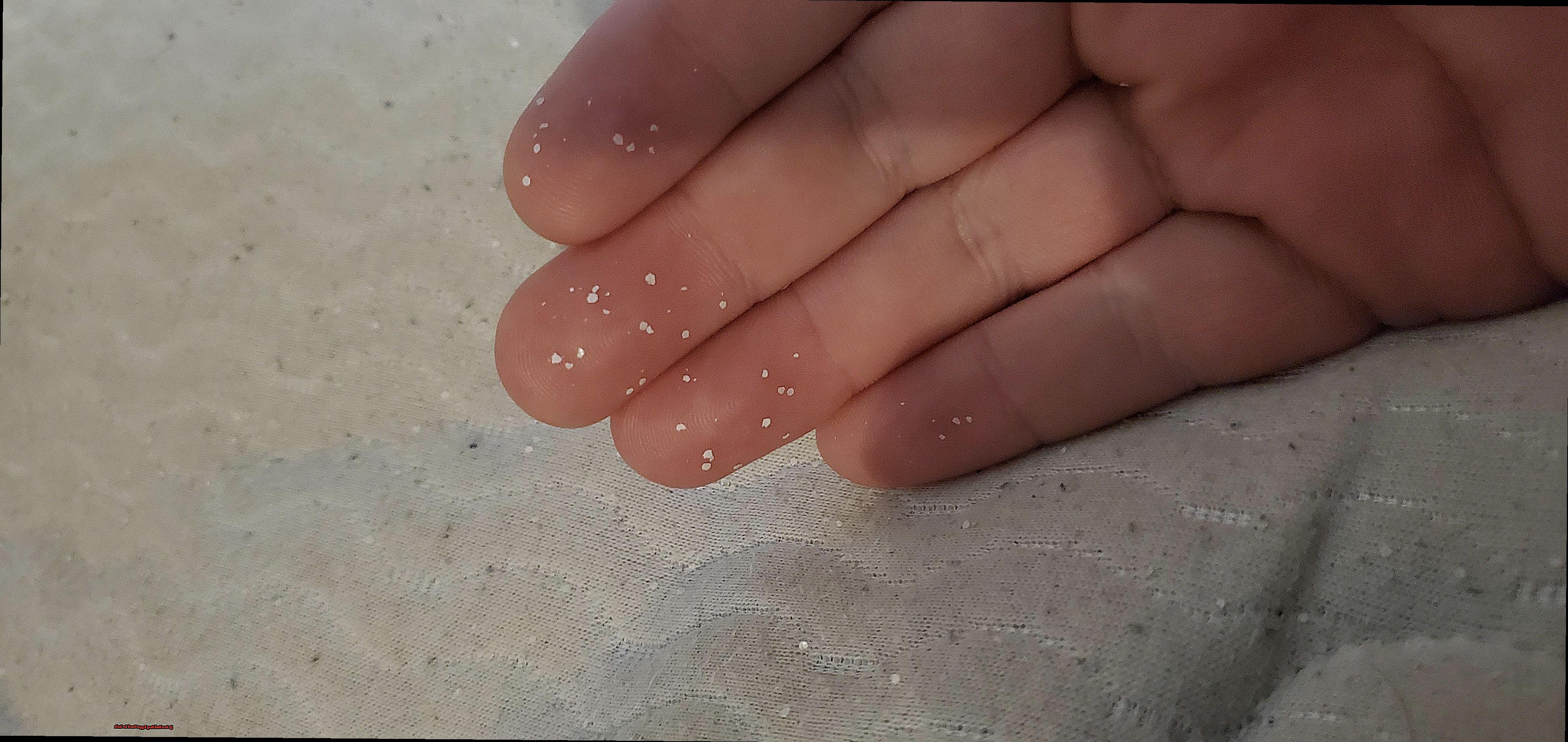
While essential oils may offer some repelling effects against bed bugs, it is crucial to implement a comprehensive approach that includes professional pest control measures for maximum effectiveness.
Signs of Bed Bugs on Wood
Bed bugs have long been a source of distress for homeowners, and with good reason. These minuscule, blood-sucking insects can quickly infest your humble abode, causing discomfort and anxiety. While they are often associated with bedding and mattresses, they can also make a home in wooden furniture.
But how can one detect if these pesky bugs have invaded their wooden furnishings? Here are the telltale signs to look out for:
Dark, minuscule spots on the wood surface or upholstery of furniture
One of the initial signs of bed bugs on wooden furniture is the presence of small, dark spots on the surface. These are actually fecal matter from the bugs, comprising of digested blood and waste. These spots may also be found on the furniture’s upholstery, as these sneaky bugs like to hide and lay eggs there.
Tiny, reddish-brown insects scurrying on the furniture
Bed bugs are renowned for their diminutive size and elusive nature, but they can occasionally be seen crawling on the surface of wooden furniture. They are about the size of an apple seed and their reddish-brown hue makes them easy to identify.
Stuck eggs and eggshells on the wood surface
Bed bug eggs are incredibly small (measuring only 1mm) and can be hard to spot without magnification. However, you may notice them as tiny white or translucent dots on your wooden furniture. You may also come across empty eggshells, a clear indication that bed bugs have been reproducing in your furniture.
Minute blood stains
As bed bugs feed on human blood, they often leave behind small blood stains on wooden surfaces. These stains may appear as tiny droplets or smudges and can be found near areas where bed bugs have been hiding.
How to Remove Bed Bugs From Wood Furniture – Step by Step Instruction
The mere thought of bed bugs infesting your treasured wooden furniture is enough to make one shudder. These minuscule parasites can easily invade your wooden pieces, making it a nightmare to sit or sleep on them. However, dear readers, do not lose hope, for I am here to provide you with effective techniques for eradicating bed bugs from wood furniture.
Step 1: Inspect and Isolate
The foremost action in eliminating bed bugs from wooden furniture is to meticulously inspect the piece. Examine every nook and cranny for any gaps, crevices, or cracks where these pests can hide and breed. Once you have located the infested areas, isolate the furniture by moving it away from other furnishings and fabrics to prevent the spread of bed bugs.
Step 2: Heat or Freeze
Bed bugs cannot withstand extreme temperatures, making heat or freezing methods effective in eradicating them. You can either expose the furniture to direct sunlight for a few hours or place it in a commercial freezer for at least four days. If you reside in a cold region, leaving the furniture outside in the snow can also do the trick.
Step 3: Vacuum and Dispose
Vacuuming is a crucial step in removing bed bugs from wood furniture. Use a vacuum with a crevice tool to suction any visible bed bugs and their eggs. Immediately dispose of the vacuum bag in a sealed plastic bag and discard it outside of your abode.
Step 4: Utilize Natural Solutions
For those who prefer natural methods, you can create a solution of borax and water, dish soap and water, or pure orange oil to spray on the infested areas. These solutions are safe to use around children and pets but may require multiple applications for optimal results.
How to Treat Wood for Bed Bugs – The Best Products
These pesky parasites have a knack for hiding in the most minuscule spaces, making it a challenging task to eradicate them from your abode. And if you happen to have wooden furniture, the thought of treating it for bed bugs without causing any damage is enough to make one’s head spin. As an experienced expert in the art of treating wood for bed bugs, I have tried and tested various methods, and I am here to provide you with the best options available.
But why are these blood-sucking bugs drawn to wood furniture, you may ask? The answer lies not in the wood itself but rather in the dark and secure hiding places it provides. With its cracks, crevices, and gaps, wooden furniture serves as the perfect habitat for bed bugs to thrive in. Furthermore, it is conveniently located near their source of sustenance – blood from humans or animals. And with female bed bugs laying up to 3 eggs per day, what starts as a small infestation can quickly escalate into a major problem.
Now, let us delve into some effective methods for treating wooden furniture for bed bugs.
Heat Treatment
One of the most powerful weapons in your arsenal against bed bugs is heat treatment. Exposing the furniture to direct sunlight for several hours or placing it in a dark plastic bag and leaving it out in the sun can effectively eliminate these pests. The temperature needs to reach a minimum of 120°F to ensure the eradication of all stages of bed bugs, including their resilient eggs. This method works best for smaller pieces of furniture.
Freezing
For those residing in colder climates, freezing temperatures can also be utilized to kill bed bugs in wooden furniture. Simply place the furniture outside in sub-zero temperatures for at least 4 days. Alternatively, you can use a commercial freezer or even leave the furniture outside during a snowstorm.
Bed Bug Marks on Wood: How to Clean Bed Bug Feces on Wood
Wooden furniture is a cherished possession in many households, adding a touch of warmth and character to any room. However, it also serves as a prime hiding spot for bed bugs, leaving behind unsightly marks and fecal stains. As an expert in this field, I have dealt with the frustration of these pests and have tested various methods for removing bed bug feces from wood furniture. In this blog post, I will share the best and most effective ways to clean bed bug marks on wood.
The Perplexing Love Affair Between Bed Bugs and Wood
Before we delve into the cleaning methods, it is essential to understand why bed bugs are drawn to wood in the first place. These blood-sucking parasites are not attracted to wood itself, but rather the narrow cracks and crevices it provides for easy hiding and breeding. This makes wooden furniture, such as beds and dressers, a perfect haven for bed bugs to thrive.
Method 1: The Bursting Power of Cold Water and Stain Removers
One of the simplest ways to remove bed bug feces from wood furniture is by using cold water and conventional commercial stain removers. Begin by wiping the affected area with a clean rag or sponge dampened with cold water. This will help loosen and remove any dried feces on the surface of the wood.
Next, apply a small amount of stain remover directly onto the affected area and gently scrub with a soft-bristled brush or toothbrush. It is crucial to test the stain remover on a small, inconspicuous area first to ensure it does not damage your furniture’s finish.
Method 2: The Mysterious Magic of Baking Soda and Water
For a more natural approach, you can create your own stain remover using baking soda and water. Mix equal parts of baking soda and water to create a paste, then apply it onto the stained area.

